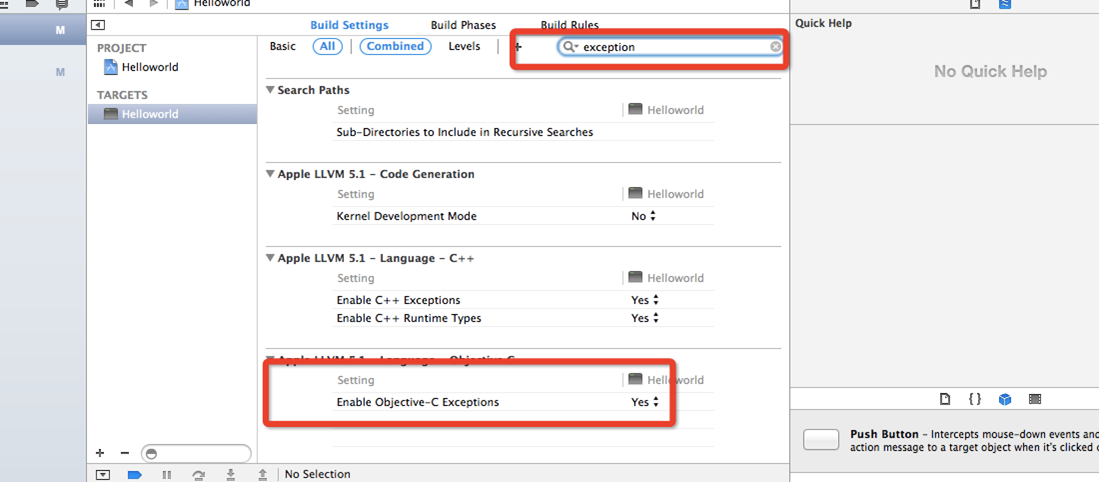Objective-C Memory Management ? ?Being Exceptional ?异常处理与内存
3.1Cocoa requires that all exceptions must be of type NSException
cocoa?需要所有的异常是NSException类型的。
so even though you can throw an exception from other objects, Cocoa isn't set up to deal with those.
所以你即使从别的类抛出异常,cocoa?也不会处理。
?
Exception handling is really intended for errors that are generated by your programs. Cocoa frameworks usually handle errors by exiting the program, which is not what you want. You should throw and catch exceptions in your code, instead of letting them escape to the framework level.
cocoa框架通常用已经存在的程序解决异常。你应该throw and catch exceptions??在你自己的代码中,而不是任其跑到框架层。
To enable support for exceptions, make sure the -fobj-exceptions flag is turned on.
为了支持异常,你应该确保-fobj-exceptions打开。

When an exception is thrown and is not caught, the program stops at the exception point and propagates the exception.
当一个异常抛出后,并没有被接到的话,则程序停在异常点。
?
3.2 ?Keywords for exceptions?
All the keywords for exceptions start with @. Here's what each one does
所以的异常keyword?均以@开头。
(1)@try: Defines a block of code that will be tested to determine if an exception
should be thrown.
测试一个异常是否应该被抛出。
(2)@catch(): Defines a block of code for handling a thrown exception. Takes an
argument, typically of type NSException, but can be of other types.
处理异常
(3)@finally: Defines a block of code that gets executed whether an exception is
thrown or not. This code will always be executed.
不管是否抛出异常都运行。
(4)@throw: Throws an exception.
抛出异常
3.3 Catching Different types of exceptions?
You can have multiple @catch blocks depending on which type of exception you want to handle.
可以根据exception?的类型来选择@catch?的类型
@try{
} @catch (MyCustomException *custom) {
} @catch (NSException *exception) {
} @catch (id value) {
} @finally {
}
?
A program throws an exception by creating an instance of NSException and using one of two techniques:
一个程序抛出异常通过创建NSException?和使用下面的技术:
(1)Using @throw exception;
(2)Sending a raise message to an NSException objectwe'll create an exception:?我们建一个NSExcepiton?
NSException *theException = [NSException exceptionWithName: ...];
We can then throw with either?我们throw?通过下面:
@throw theException;
or
[theException raise];
You'll usually throw exceptions from inside the exception handling code.
也可以在一个exception handling code里再抛出异常。
@try {
? ? NSException *e = ...;
@throw e; }
? @catch (NSException *e) {
?? ? @throw; // rethrows e.
}
2.4 Exceptions need memory management too .?异常也需要内存管理
?
Memory management can be tricky when exceptions are involved.
- (void)mySimpleMethod
{
? ? NSDictionary *dictionary = [[NSDictionary alloc] initWith....];
? ? [self processDictionary:dictionary];
? ? [dictionary release];
}
let's imagine that processDictionary throws an exception. The program jumps out of this method and looks for an exception handler. But because the method exits at this point, the dictionary object is not released, and we have a memory leak.
假如processDictionary?抛出异常,但是dictionary?还没有释放,因此有了memory leaks .
解决办法:One simple way to handle this is to use @try and @finally, doing some cleanup in @finally because it's always executed (as we said earlier).
在@finally?处处理,因为总是执行。
- (void)mySimpleMethod
{
? ? NSDictionary *dictionary = [[NSDictionary alloc] initWith....];
? ? @try {
?? ? [self processDictionary:dictionary];
? ? }
? ? @finally {
? ? [dictionary release];
? ? }
}
?
2.5 Exceptions and autorelease pools ? 异常和自动释放池
Exceptions are almost always created as autoreleased objects because you don't know when they will need to be released. When the autorelease pool is destroyed, all objects in that pool are destroyed also, including the exception.
Exceptions?几乎总是被创作为自动释放因为你不知道什么时候结束。
?
? - (void)myMethod
{
? NSAutoreleasePool *pool = [[NSAutoreleasePool alloc] init];
? NSDictionary *myDictionary =
? ? [[NSDictionary alloc] initWithObjectsAndKeys:@"asdfads", nil];
? @try {
? ? [self processDictionary:myDictionary];
? } @catch (NSException *e) {
? ? @throw;
? } @finally {
? ? [pool release];
? }
}
There's a problem when we think about exception handling. We discussed earlier that we can rethrow exceptions in the @catch block, which causes the @finally block to execute before the exception is rethrown.
我们可以rethrow exceptions?在@catch block中。这导致了@finally在异常抛出前执行。
This will cause the local pool to be released before the exception can be delivered, thus turning it into a dreaded zombie exception.
这将导致恐怖的zombie exception.
- (void)myMethod
{
? id savedException = nil;
? NSAutoreleasePool *pool = [[NSAutoreleasePool alloc] init];
? NSDictionary *myDictionary =
? ? [[NSDictionary alloc] initWithObjectsAndKeys:@"asdfads", nil];
? @try {
? ? ? ? [self processDictionary:myDictionary];
? } @catch (NSException *e) {
?? ? ? savedException = [e retain];
?? ? ? @throw;
? } @finally {
?? ? ? [pool release];
?? ? ? [savedException autorelease];
? }
}
By using retain, we saved the exception in the parent pool. When our pool is released, we already have a pointer saved, and when the parent pool is released, the exception will be released with it.
通过retain?,我们保留了这个exception?在parent pool。
?
?
?
?
?